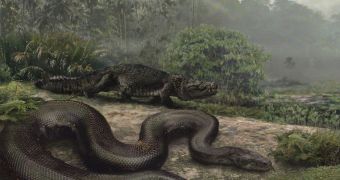In the Geology Building of the Indiana University (IU) Bloomington, organizers have begun displaying remains of the largest snake to have ever slithered across the surface of the Earth.
The massive beast measured 13.1 meters (43 feet) in length from its snout to the end of its tail, and weighed in at a massive 1,133 kilograms (2,500 pounds), which made it impressive to look at.
But no human or hominid saw this particularly interesting reptile, as carbon dating of the scarce fossils researchers have been able to identity thus far show the animal lived no less than 60 million years ago.
At the IU Bloomington exhibit, researchers have only displayed a cast of a single vertebra belonging to the snake, called Titanoboa cerrejonensis. As the name implies, the animal was most likely an ancestor of the large, modern-day boa constrictor.
However, the “new” snake variety has nothing against its ancestor, which is so impressive it could easily be pitted against most existing creatures without a clear outcome.
“At its greatest width, the snake would have come up to about your hips,” explains paleontologist David Polly, the expert who published a paper last year, detailing the discovery of the Titanoboa.
The research was published in a 2009 issue of the esteemed scientific journal Nature. The document shows that the snake could have easily consumed the larger reptiles, fish and mammals of its day.
The fossils of Titanoboa have been found in northeast Colombia, in an open-pit coal mine, and those called to investigate the bones have noticed that the vertebrae looked like those of a snake, but that they were also severely over-sized.
Studies conducted on the remains afterwards have proved the age of the remains, as well as the implications they generated.
Some 60 million years ago, the climate around the tropic was very warm and very moist, with rain falling down almost every day.
As the dinosaurs were gone, all the animals that remained were ancestors to species found today in the world. The giant snake most likely devolved into the boa, becoming slightly less larger and heavier, but adapting better to living in trees and strangling its prey to death.

 14 DAY TRIAL //
14 DAY TRIAL //